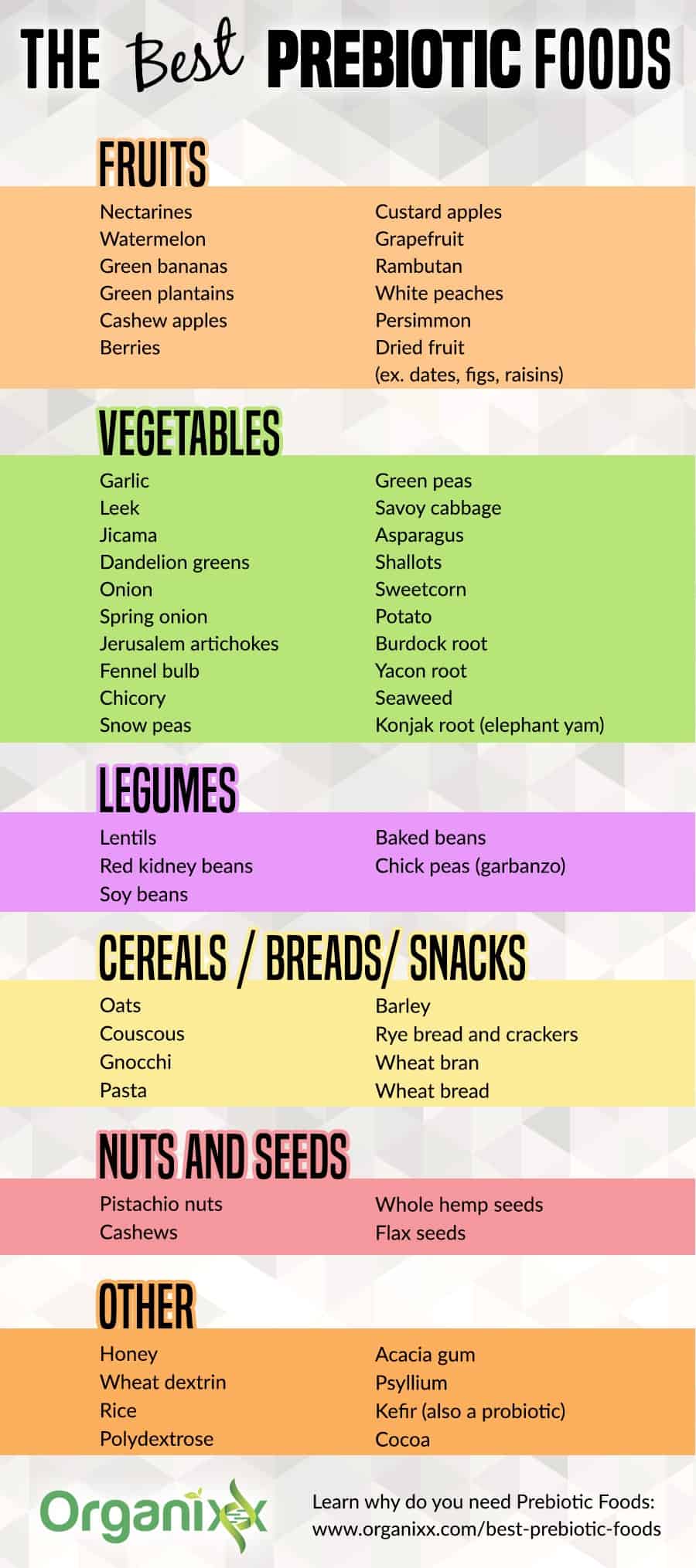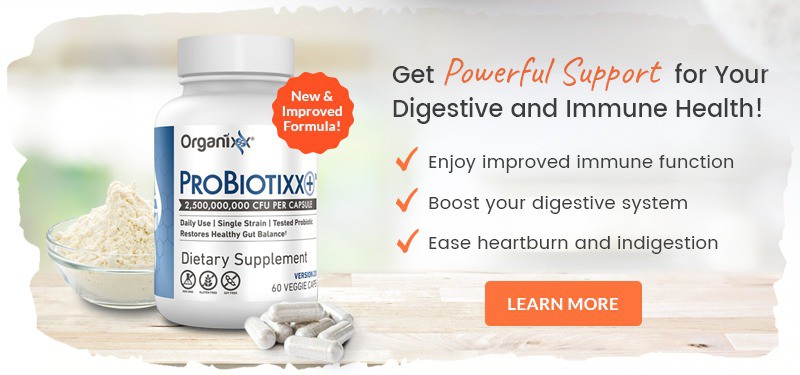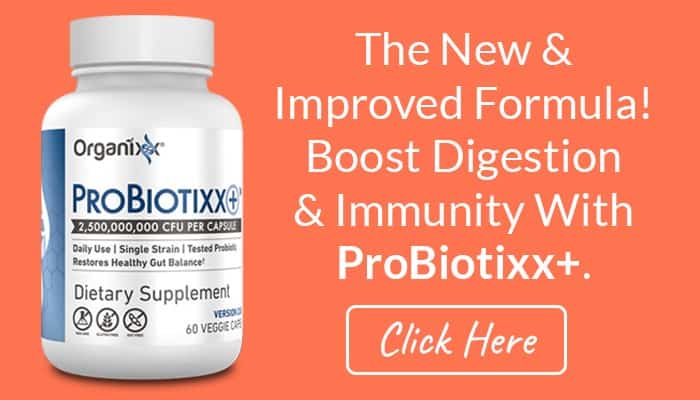The Best Prebiotic Foods and Why You Need Them
In a hurry? Click here to read the Article Summary...
Ensuring your gut bacteria (your microbiota) are in balance is of the utmost importance to your overall health and well-being. This microbial system, teeming with trillions of organisms (including beneficial bacteria), comprises what is known as your microbiome.
Scientists are finding increasing evidence that your gut and microbiome, though previously overlooked, actually participate in or even control several systems in your body. In fact, the microbiome has shown to have so much bodily influence that it’s being called “the second brain [1].”
Researchers have documented how this second brain influences immunity, the production and upregulating of serotonin and dopamine (as well as many other hormones and chemicals)[2], hypertension, mood, depression, weight regulation, inflammation, and more [3].
On the other hand, a compromised microbiome (a condition known as dysbiosis) can lead to disease, allergies, obesity, autoimmune issues, and worse [4].
You may be aware that probiotics (healthy gut bacteria) are essential for your gut (microbiome) health. Supplementing with a quality probiotic product, and/or incorporating fermented and other probiotic foods, is a basic measure to kickstart, improve, or maintain a healthy microbiome [4].
However, there is another piece of the healthy microbiome puzzle that many people miss out on… PREbiotics.
What Are Prebiotics?
Though the exact definition of prebiotics is under review [5], the generally accepted definition of prebiotics is best put by the Mayo Clinic:
“Prebiotics are nondigestible substances that act as food for the gut microbiota. Essentially, prebiotics stimulate growth or activity of certain healthy bacteria that live in your body [6].”
 It certainly seems logical that if you want a healthy set of microbiota (gut flora), you would “feed” them and encourage them to thrive. Yet, few people are familiar with the concept.
It certainly seems logical that if you want a healthy set of microbiota (gut flora), you would “feed” them and encourage them to thrive. Yet, few people are familiar with the concept.
A study published in 2015 shared results of a survey of 200 adult inpatients at an urban hospital. Only 11% of respondents knew the term “prebiotic,” and only 7% picked the right definition out of the four other choices [7].
Of more concern is that in a survey of 245 health care providers (100 of which were doctors), only 22% were familiar with the term. Also worrying, there was distinct confusion among this group about the differences between probiotics and prebiotics [8].
Despite this appearance of common ignorance, prebiotics, as they relate to our microbiome and overall health, are getting increasing attention from the scientific community. This is largely due to the extreme importance of a healthy gut, as mentioned above.
The Impact of Adding Prebiotic Foods to Your Diet
In fact, there is some evidence that “just” adding prebiotics to your diet can have profound effects on your microbiota. In what appears to be a somewhat informal study devised by Gemma Walton, Ph.D., School of Food Biosciences at the University of Reading in the UK, the BBC Science and Nature page reported the following in 2014 [9]:
We took 8 hard-working cowboys, and divided them into two groups. Half of them were put on a diet of probiotics − cultures containing good bacteria found in foods such as yoghurt. The other half we put on a prebiotic diet − substances found in certain vegetables such as leeks and bananas, which make the pre-existing good bacteria in the gut healthier.
Then we got down to the dirty work. Their poo was examined daily to measure the change in bacteria. If the good bacteria are fed well they should multiply in number and make the ranchers healthier.
The cowboys’ poo showed that the prebiotic group managed to increase their good bacteria numbers by 133 million, small in bacteria terms, but an encouraging effect. The probiotic group saw little change over the week, but over a longer period there’s evidence that they can make a difference.
It seems from our investigation the best thing you can do for your bacterial health is treat your good bacteria to a prebiotic meal.
The conclusions drawn from this small study is gaining evidence in formal research as well [10]. More so, science is demonstrating that the combined one-two punch of using both prebiotics and probiotics has significant potential for improvement in various conditions, and contributing to long-term health [11].
So what are these “nondigestible substances” that can have such a meaningful impact on our health and microbiome?
A Closer Look at Prebiotics
Generally speaking, prebiotics are fiber. They are insoluble fiber that cannot be completely digested, and can survive the small intestine, arriving at the large intestine to feed your microbiota. Such fibers include [12]:
- inulin
- fructo-oligosaccharides (fructans, FOS)
- galacto-oligosaccharides (GOS)
 Eating foods high in fiber has long been considered to better your health, across the board [13,14]. Many of us end up with a compromised microbiome by way of antibiotics, stress, high sugar and low-quality, high-fat diets, and eating few probiotic foods.
Eating foods high in fiber has long been considered to better your health, across the board [13,14]. Many of us end up with a compromised microbiome by way of antibiotics, stress, high sugar and low-quality, high-fat diets, and eating few probiotic foods.
Not eating enough fiber to nourish the microbiome − the typical Western diet − is another way we can inadvertently create imbalance in our microbiota [15].
Good bacteria can die off, and other bacteria, as well as viruses and fungi, can gain the upper hand [16]. But it doesn’t end there.
According to Monash University of Medicine, Nursing and Health Sciences in Australia, the benefits of a diet abundant in prebiotic fiber also include [12]:
- elevated satiety (feeling full)
- weight management
- reduced symptoms and incidence of IBS
- improving overall immune function
- protection from gut infections
- an increase in the uptake of minerals like calcium and magnesium.
Other Prebiotic Sources
While most prebiotic food sources are fiber, not all are. The scientific requirement to be classified as a prebiotic food is a food that [14]:
- resists gastric acidity, hydrolysis by mammalian enzymes, and absorption in the upper gastrointestinal tract
- is fermented by the intestinal microflora
- selectively stimulates the growth and/or activity of intestinal bacteria
Recently, some starches have also gained attention as prebiotics. These are termed “resistant starches [17,10].”
Resistant starches also make it through your digestive system through to your large intestine, and due to their “resistance” to being digested, serve as a buffet line for your gut flora. (NB: Those with leaky gut and other conditions with compromised gut linings need to be cautious when introducing resistant starches to the diet [27].)
So with all this in mind, what exactly are the best prebiotic foods that are high in prebiotic fiber?
The Best Prebiotic Foods
The best prebiotic foods, encompassing the known types, are [6,12,14,16,18-20]:
Fruits
Nectarines, watermelon, green bananas, green plaintains, cashew apples, berries, custard apples, grapefruit, rambutan, white peaches, persimmon, and dried fruit.
Vegetables
Garlic, leek, jicama, dandelion greens, onion, spring onion, Jerusalem artichokes, fennel bulb, chicory root, snow peas, green peas, savoy cabbage, asparagus, shallots, sweet corn, potato, burdock root, yacon root, seaweed, and konjak root.
Legumes
Lentils, red kidney beans, soybeans, baked beans, and garbanzo beans (chickpeas).
Cereals/Breads/Snacks
Oats, couscous, gnocchi, pasta, barley, rye bread & crackers, wheat bran, and wheat bread.
Nuts & Seeds
Pistachio, cashews, whole hemp seeds, and flax seeds.
Other
Honey, wheat dextrin, rice, polydextrose, acacia gum, psyllium, kefir, and cocoa. 
A special note on rice, potatoes, and pasta: the prebiotic “resistant” qualities intensify if you cook, then COOL these foods [21]. Thus, pasta or potato salad, and a cold rice pudding or salad would have stronger prebiotic qualities than fresh-cooked.
As with any food, finding the best quality form of all the above is vital. Choose organic wherever possible, and at minimum, food that has not been irradiated [22,23].
The One-Two Punch of Prebiotics & Probiotics
Of course, the purpose of eating all these healthful and delicious foods is to promote the vitality of the probiotics already in your body. It’s making the most of what you have.
It stands to reason, and is being confirmed by researchers, that the combination of eating prebiotic foods and probiotic foods is the ideal. Eating probiotic and fermented foods and substances that are an excellent source of enzymes, anaerobes, lactic acid, probiotic strains, and more, is a foundation, and relatively easy to accomplish.
However, in this day and age, we can’t count on food alone to get all the strains of microbes we need to have the most diverse and healthy microbiome.
Supplementing with a quality probiotic that is plant-based (not over-sensitive to heat and other conditions that can cause die-off between manufacture and home), with strains such as Bacillus coagulans and Lactobacillus plantarum [24-27] that can survive the stomach and upper gastric tracts, as well as consuming probiotic-encouraging prebiotics is the one-two punch your microbiome, health, and well-being needs to be at optimal function.
One closing note: If you have gastrointestinal issues or other health concerns, seek medical advice from a qualified healthcare practitioner.
Organixx ProBiotixx+ formula contains a single, super-strain of Lactobacillus plantarum, designed to help alleviate constipation… eliminate gas and belly bloat… support your entire immune system… and give you total digestive protection.

 Sources:
Sources:
Article Summary
A compromised microbiome can lead to disease, allergies, obesity, autoimmune issues, and more.
Prebiotics are indigestible substances that act as food for the gut microbiota.
Adding prebiotics to your diet can have profound effects on your microbiota.
Using both prebiotics and probiotics has significant potential for improvement in various conditions and contributing to long-term health.
Benefits of prebiotic fiber include:
- Feeling full
- Weight management
- Reduced symptoms and incidence of IBS
- Improving overall immune function
- Protection from gut infections
- An increase in the uptake of minerals like calcium and magnesium.
The best prebiotic foods are fruits, vegetables, legumes, cereals, nuts, and seeds.




Hello, would you pls be so kind & more specify in details & name the fruits & vegies we should eat???
Thanks a lot.
Blessings
Regine
Hi Regine, I am happy to help. The best prebiotic fruits and vegetables are listed below in no particular order. You can also find this information at the bottom of the article. Have an awesome day! :)
Fruits
Nectarines, watermelon, green bananas, green plantains, cashew apples, berries, custard apples, grapefruit, rambutan, white peaches, persimmon, and dried fruit.
Vegetables
Garlic, leek, jicama, dandelion greens, onion, spring onion, Jerusalem artichokes, fennel bulb, chicory root, snow peas, green peas, savoy cabbage, asparagus, shallots, sweet corn, potato, burdock root, yacon root, seaweed, and konjak root.
Thanks for the futuristic article. It is quite educative and hope I will put it into practice.
Absolutely, Tot!
Thank you so much for taking the time to take a look at this article. We're glad you found this piece informative.
We'd love to see you again in our next article. Wishing you a great day!
Thanks for the information. Why can't we copy the sources at the end of the article? If I am copying an article, I want the sources along with the body of the article.
Hi Amanda,
I just tried copying the links and had no issue. Another thing you could do is open the links and then copy the hyperlinks from your browser window.
Genesis 1:29
...I have given you every herb bearing... and every tree, yielding seed; to you it shall be for meat.
Trust your Creator and find ancient grains(einkorn wheat verses modern) and follow age old preparation methods for all seeds(nuts, grains, ect)
AND ALSO- Once your microbes are strong and in balance, a lot of issues we are warned against with certain foods are no longer an issue. They are an issue only because our gut is so weak and sickly in the first place. ALL BE BLESSED
Hi Ty and the team
You should also include a section with a list of herbal prebiotics
Thank you for the good job
Kind regards